Nostalgia: your untapped local marketing opportunity
Sponsored by Semrush , written by Miriam Ellis
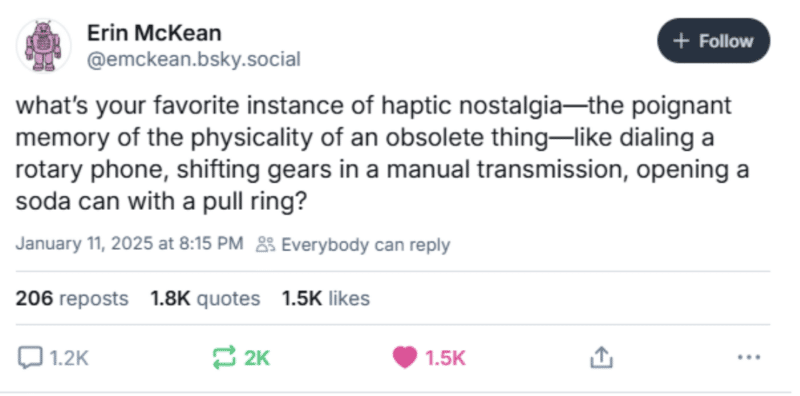
One of the first posts I saw go viral on Bluesky in the new year was this one, above, about nostalgia, started by Erin McKean. Some of the old-time sensory experiences the 1.2K respondents mentioned missing included opening sodas with retro ring pulls, pressing chunky buttons on cassette recorders, hearing dial-up modem connection sounds, twizzling phone cords, sliding video tapes into VCRs, feeling static after shutting off TV screens, rolling camera film forward, putting floppy disks into disk drives, and having phones you could slam down in moments of high drama (don’t do this with a cell phone!).
Just as individuals have nostalgic feelings about bygone tactile experiences, local communities can have collective nostalgia for brands, goods, and services that are no longer available in their hometowns.
Today, I’d like to offer a curated selection of conversations pertaining to this fascinating topic, which I’ve been gathering from social media. My hope is that you can use this column to spark discussions with the small-to-enterprise local brands you’re marketing to discover nearby consumer desires that are going unfulfilled. I’ll also offer suggestions for conducting your own local nostalgia research for the purposes of business intelligence and marketing.
What business nostalgia looks like
This entire Reddit thread is a master class in the warmth and vigor with which communities experience nostalgia for absent businesses, goods, and services. The comment below shows how a consumer can instantly reel off a considerable list of unmet local needs like appliance repair shops, used bookstores, and bespoke clothing stores with on-site alteration services, and receive lots of affirmation via upvotes from fellow shoppers:

The above poster voices the common complaints that retail stores are no longer staffed by experts and that costly merchandise is no longer built to last. In fact, one of the chief points of nostalgia voiced in this massive thread is that people can no longer find anyone to repair worn or broken merchandise in our throwaway culture.

The absence of these services in some communities causes people in other towns to boast of still having access to these desired resources:
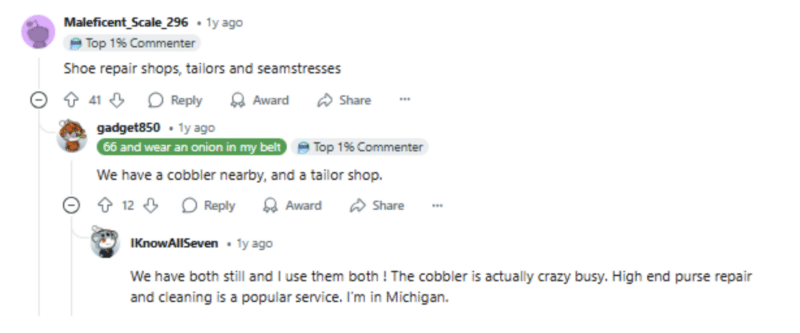
From reading through 600+ comments in this thread, I’ve learned that:
- People really miss shoe repair shops—dozens of people mentioned this
- Similarly, full-service gas stations are remembered with longing
- Multiple people referenced a lack of trained staff and some mentioned that they feel unsafe and uncomfortable visiting understaffed stores
- Drive-in restaurants and movie theaters would be patronized by many commenters, if these resources still existed
- Many people feel that the next-day delivery service offered by remote shipping companies isn’t a good replacement for being able to get desired goods and services the same day at local stores
- The brand that’s most missed, at least in this sample group, is Radio Shack. People found this a very convenient store for a variety of electronic needs. Woolworths is also repeatedly referenced for its once-beloved lunch counter.
What it looks like when nostalgic needs are successfully served
Absent lunch counters were frequently referenced in the above Reddit thread. The ensuing conversation also contained a textbook example of how customers whose nostalgic needs have been met will do your marketing for you.
Take a look at this example and read the final comment in which a random consumer is doing unpaid PR for a named local brand:
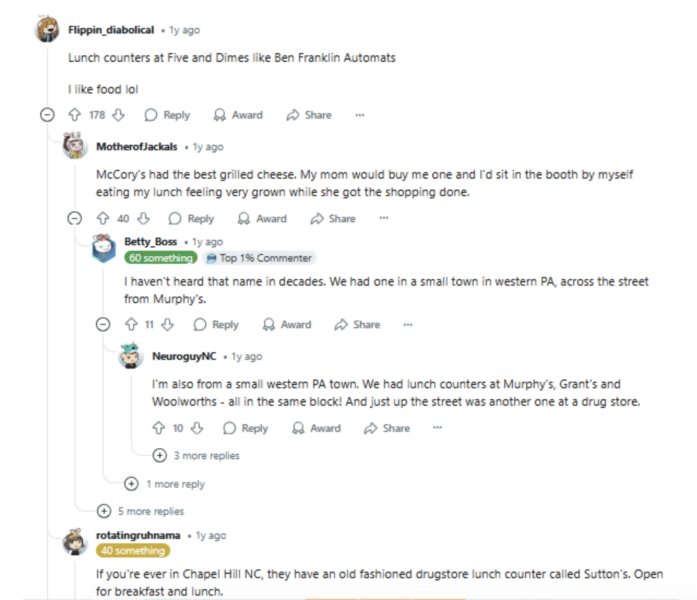
It was the perfect set-up: in a thread where people were sharing various lunch counters in their area that are no longer in existence, one user chimed in with a recommendation for one still functioning in Chapel Hill, NC.
A different nostalgic need I’ve kept track of for years is rooted in the confusion caused when the drugstore chain Thrifty was bought by a different chain called Rite-Aid in the mid-90s, and Thrifty’s famous ice cream counters disappeared. This brand has such a cult following that subsequent acquisitions made the fate of the ice cream newsworthy:
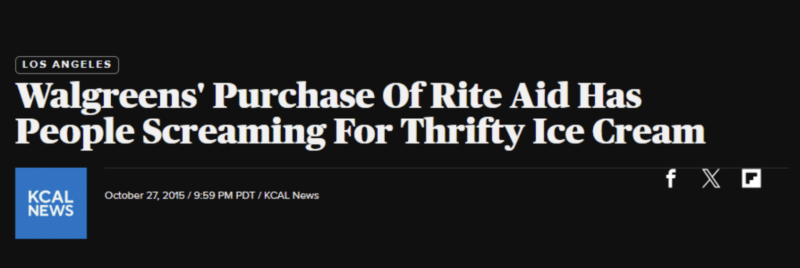
There are countless Reddit threads in which people are fondly remembering this ice cream from childhood, trying to understand if it it still exists, discussing its many flavors, and even evangelizing the product to people who have never tasted it:
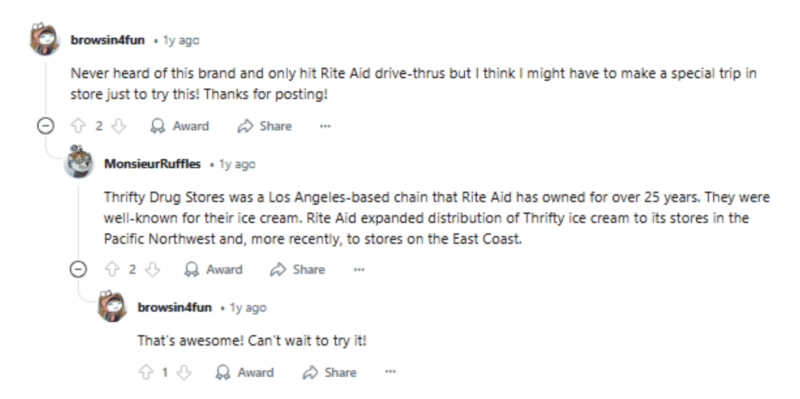
The takeaway here is that if you can identify and fill a nostalgic gap in the market, consumers feel passionate enough about it to give you free word-of-mouth (WOM) referrals.
Local businesses should pay particular attention to this in light of the findings of a survey I recently conducted with GatherUp, which revealed that local consumers trust the recommendations of friends and family far more than they trust traditional online local business reviews:
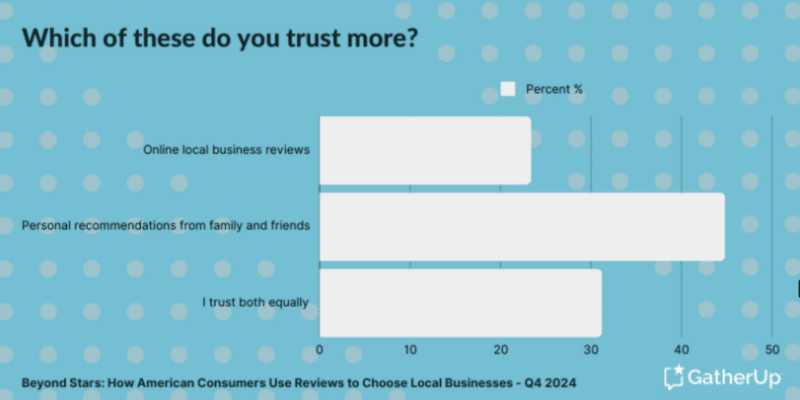
While an online friend may not be the same as an offline one, the entire search marketing industry has been tuned into the recent rise of Reddit’s visibility in Google’s SERPs, and a dominant narrative in this trend is consumer desire for trustworthy, authentic conversations vs. marketed messaging.
WOM recommendations and customer loyalty have long been seen as ultimate local business goals. Right now, strategic brands should be actively seeking strongholds amid the threat of AI to genuine brand-consumer relationship building.
A landmark study by The Transparency Company reveals that, beginning in June 2023, AI-generated local business reviews have grown 80% month-over-month, to date. As online review platforms become more polluted over the next few years with AI content, it’s safe to predict that they’ll become less trusted. Smart brands will need to work harder to earn and elevate the voices of passionately loyal patrons. As we’ve seen from the above examples, nostalgia is a strong force.
Researching nostalgia gaps in your local markets
Take the following steps to discover where there are local needs your community is missing:
- Monitor your own brand mentions
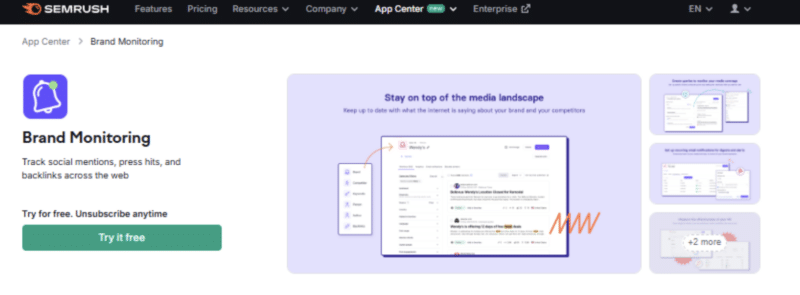
To tap into local nostalgia, your first step is to practice awareness of the mentions currently being made of your brand. Use a free trial of a product like SEMrush’s Brand Monitoring tool and pay attention to whether consumers are expressing feelings of loss over products, services, and customer service standards at your locations.
If a former SKU, amenity, or policy has disappeared and a tool like this gives you evidence that it’s missed, you may need to consider operational changes to restore a lost and popular offering. Some brands, like The Vermont Country Store, have built an entire business model around selling storied products that have become hard to find.
- Poll your customers
Use your email list or social profiles to take a poll to find out which brands, products, and services your communities miss most. Your survey results may turn up needs you can’t possibly fulfill, but they’ll at least bring openness to the findings.
For example, let’s suppose you’re running a hardware franchise and you empower your franchisees to take a nostalgia poll at multiple locations across the US. Imagine that your poll reveals that, like my Reddit examples, a significant portion of your consumer base is missing cobblers, appliance repair services, and drive-in movie theaters because these three things no longer exist in their towns and cities.
Would it be too big of a stretch to find a space for a shoe repair kiosk on your premises? If you could make it happen and market it well, you’d have a local monopoly.
How about a new counter for fixing smaller appliances like blenders, toasters, and vacuum cleaners? With enough online buzz and offline WOM, you could corner this market in a community.
Maybe you don’t have enough square footage to install a permanent drive-in movie theater, but could you team up with other local business owners to sponsor a monthly community drive-in movie night in the parking lot of an abandoned business park or shopping center?
B2B networking is just good business, and savvy local brands are always on the lookout for becoming more involved in their communities.
- Consult archival data
If your city still has a local newspaper, chances are good that it has both an archive of past business articles as well as periodic new content based in nostalgia. Study these resources to understand how the local commercial landscape has changed over the past 50 years, and pay careful attention to reporting on the absent amenities of life which local people still recall with passion.
Articles like the following one from a California newspaper will frequently feature energetic comment sections filled with locals regretting lost businesses.

The comments section of that article features people reminiscing about growing up near Petaluma Blvd, cheering on the Raiders, and going to concerts in the ‘80s. Along the way, they drop the names of beloved local businesses like Old Chicago Pizza and The Cantina. There’s lots to dig into if you want to get familiar with the area.
Of course, some business models and services probably can’t be resurrected. I’ve seen many instances of people waxing poetic about hanging out at malls in their youths. Publishers are currently arguing over whether malls are dead or are capable of adapting to changed circumstances.
But don’t discount every shopping experiment as a bygone of yesteryear—some have staged amazing comebacks. Just a decade ago, who could have imagined the resurgence of grocery delivery we’ve witnessed over the past few years?
Next steps: Social listening & brand monitoring
Marketers and SEOs spend large portions of our careers trying to identify opportunities amid consumer behavioral trends. We ride waves – some that are major and some that are short-lived – with our clients. Nostalgia is such an old and reliable force that it exists in some of the most ancient texts in the world in which we see our ancestors longing for the good old days. It’s hard to think of a better energy to tap into if we want our customers to tell their peers about us with genuine enthusiasm.
A combination of social listening and brand monitoring, active surveys, and archival research can be useful tools for discovering nostalgia-based gaps surrounding multiple locations of your brand. Time and again, we discover that if we have the patience to really listen to what customers say they want, we can become local heroes by meeting stated needs with practical solutions.